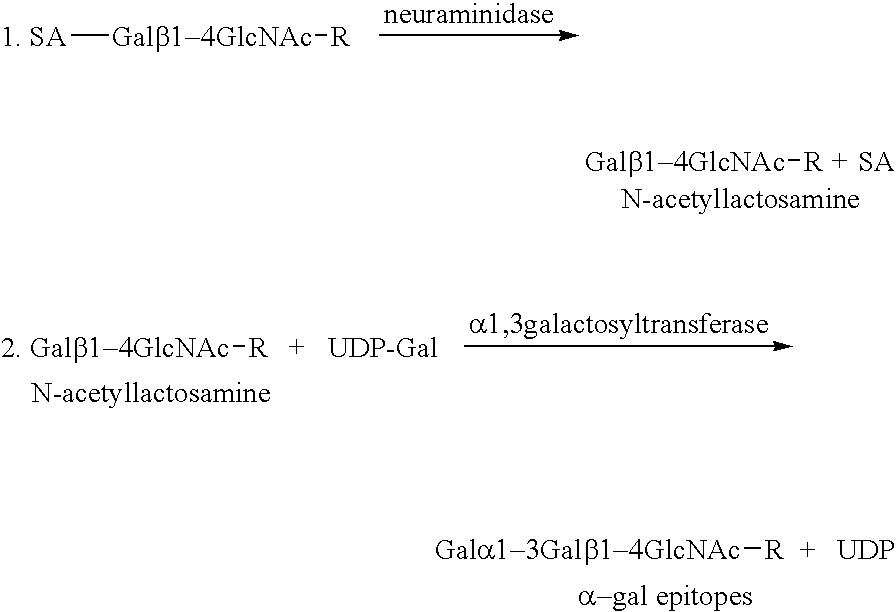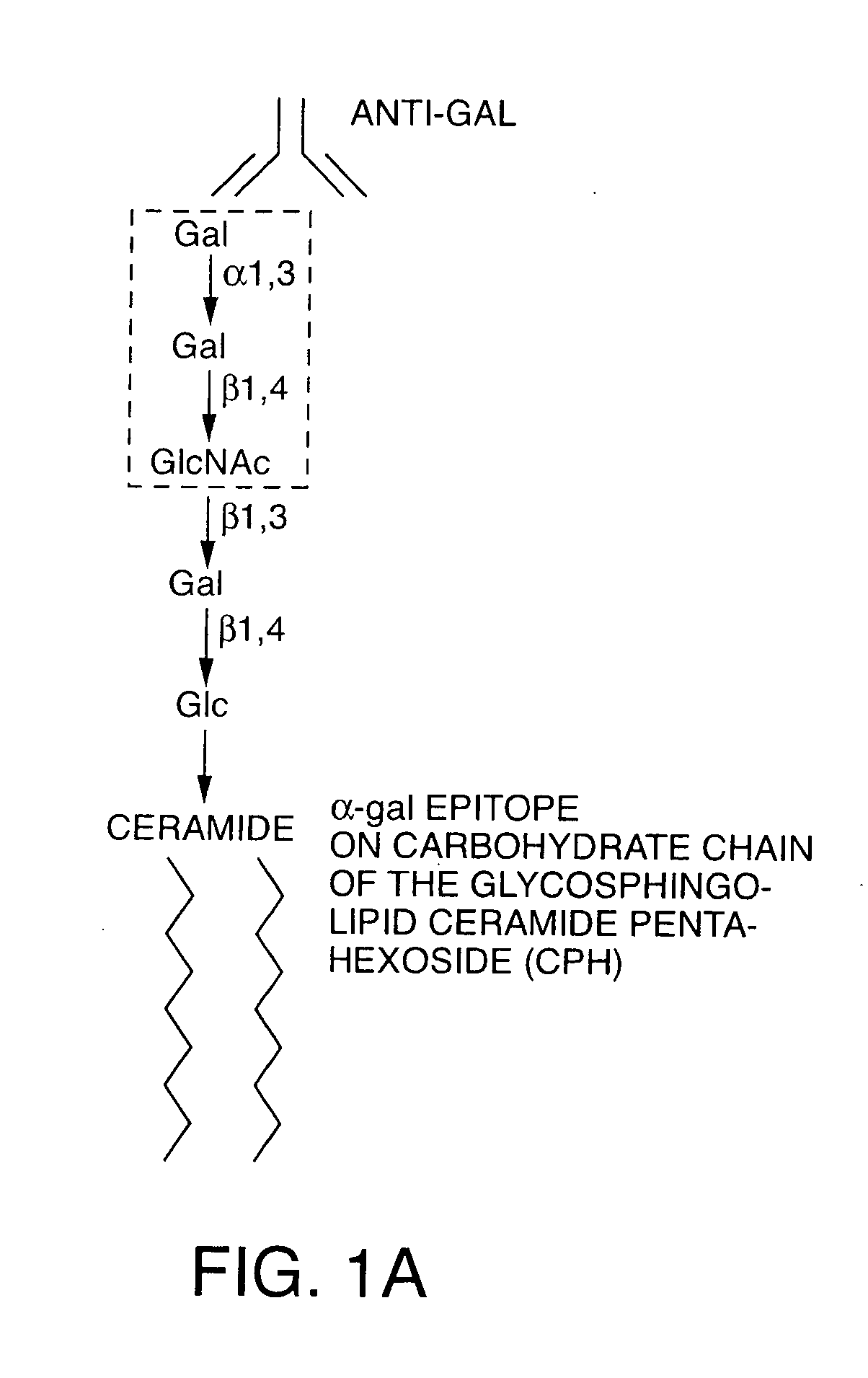Tumor lesion regression and conversion in situ into autologous tumor vaccines by compositions that result in anti-Gal Antibody Binding
a tumor lesion and anti-gal antibody technology, applied in the field of cancer treatment, can solve the problems of patient death, immune-mediated detection, regression, and/or destruction of micrometastases, and achieve the effect of reducing the growth of at least one of said untreated non-resectable solid tumors
- Summary
- Abstract
- Description
- Claims
- Application Information
AI Technical Summary
Benefits of technology
Problems solved by technology
Method used
Image
Examples
example 1
Extraction of α-Gal Glycolipids from Rabbit and Bovine Red Blood Cell Membranes
[0168] A rich source for α-gal glycolipids is rabbit red blood cells. The two major glycosphingolipids (GSL), i.e. glycolipids with ceramide tail, in rabbit red blood cell membranes are ceramide (Cer) trihexoside (CTH, with 3 sugars [hexoses], present also in human red blood cells) with the structure Galα1-4Galβ1-4Glc-Cer and ceramide pentahexoside (CPH, with 5 sugars [hexoses]) with α-gal epitopes as terminal part of the CPH structure of Galα1-3Galβ1-4GlcNAcβ1-3Galβ1-4Glc-Cer (Eto T, Iichikawa Y, Nishimura K, Ando S, Yamakawa T J. Biochem. (Tokyo) 1968; 64: 205-13, and Stellner K, Saito H, Hakomori S. Arch. Biochem. Biophys. 1973; 133: 464-72) (See FIG. 1 and FIG. 6A, lane 1). Immunostaining of rabbit α-gal glycolipids on thin layer chromatography (TLC) plates with human natural anti-Gal resulted in binding of the antibody to CPH but not to CTH (See FIG. 6A, lane 2). This immunostaining revealed also th...
example 2
Binding of Autologous Anti-Gal to Cells with Inserted α-gal Glycolipids and Subsequent Complement Mediated Lysis of Such Cells
[0173] Insertion of α-gal glycolipids into autologous cell membranes can be demonstrated by incubation of human red blood cells with 1 mg / ml of α-gal glycolipids for 2 h at 37° C. After extensive washing to remove unbound α-gal glycolipids, the expression of α-gal epitopes can be demonstrated by the incubation of the red blood cells with heat inactivated autologous serum that was diluted 1:2 in phosphate buffered saline (PBS). The binding of autologous anti-Gal to the inserted α-gal glycolipids was demonstrated by incubation of these red blood cells with phycoerythrin coupled anti-human IgG and analysis of staining by flow cytometry. The bound antibodies was indicated by the shift in binding of IgG antibodies in comparison with control untreated red blood cells (See FIG. 8A, thick line histogram and dotted line histogram, respectively). The antibodies bindin...
example 3
Insertion of α-Gal Glycolipids into Tumor Cell Membranes and Subsequent Complement Mediated Lysis of Cells with the Inserted α-Gal Glycolipids
[0175] This example demonstrates an in vitro mouse tumor model showing the insertion of α-gal glycolipids into tumor cell membranes and the subsequent binding of anti-Gal. This model utilizes B 16 melanoma cells (mouse tumor cells lacking α-gal epitopes) that form tumor lesions in mice having an H-2b genetic background.
[0176] B16 cells in RPMI medium supplemented with 10% fetal calf serum were incubated with 1 mg / ml, 0.1 mg / ml, or 0.01 mg / ml of α-gal glycolipids for 2 h at 37° C. with constant rotation. After extensive washing to remove unbound α-gal glycolipids, the display of α-gal epitopes was demonstrated by binding mouse anti-Gal IgG purified on α-gal affinity column from serum of α1,3galactosyltransferase knockout mice that produce anti-Gal.
[0177] After 2 h incubation at 4° C. with the anti-Gal antibody the cells were washed and incub...
PUM
| Property | Measurement | Unit |
|---|---|---|
| diameter | aaaaa | aaaaa |
| diameters | aaaaa | aaaaa |
| pH | aaaaa | aaaaa |
Abstract
Description
Claims
Application Information
 Login to View More
Login to View More - R&D
- Intellectual Property
- Life Sciences
- Materials
- Tech Scout
- Unparalleled Data Quality
- Higher Quality Content
- 60% Fewer Hallucinations
Browse by: Latest US Patents, China's latest patents, Technical Efficacy Thesaurus, Application Domain, Technology Topic, Popular Technical Reports.
© 2025 PatSnap. All rights reserved.Legal|Privacy policy|Modern Slavery Act Transparency Statement|Sitemap|About US| Contact US: help@patsnap.com



